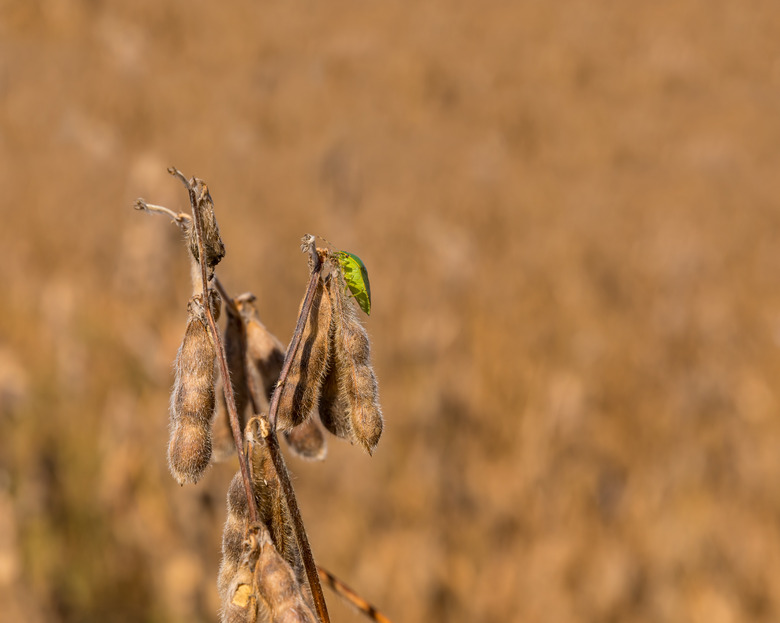Fun Facts About Stink Bugs For Kids
The name alone makes people want to avoid stink bugs. They got the name because they release a smelly odor when they're protecting themselves from other bugs or when crushed. They are sometimes called "shield bugs" because of their shield-shaped wings. This pest resists many pesticide applications, especially inside homes. The brown marmorated stink bug (BMSB), accidently introduced from Asia in the 1990s, has become a particular problem for home and commercial farmers.
Stink Bugs Definitely Stink
People, as well as creatures like mice, lizards and birds, can intimidate the stink bug into releasing their foul-smell from special glands. Smell is a hard thing to describe since it is different for every person, but some people describe the odor as a sharp, fruity, bitter smell. Other people have said the scent is like sweaty feet, cilantro or a spicy vegetable odor. The smell is attractive to other stink bugs, who will follow the smell to find another place to live.
Identifying Stink Bugs
Stink bugs are triangle-shaped and about 3/4 inches long. They can be gray, brown, or dark green in color. Stink bugs may have red, pink or yellow markings. Like other true bugs, they have six legs, wings, and antennas. In adults, the wings form a distinct shield shape, giving them the nickname 'shield bugs'. Stink bugs occur naturally in North America, but two exotic species, the brown marmorated stink bug and bagrado bug, now are found in the United States. The bagrado bug has a very limited range. The invasive brown marmorated stink bug (BMSB, for short), however, has become a serious problem for farmers. BMSB can be identified by the light bands on their dark antenna, smooth "shoulders", and the alternating light-dark banding along the edges of their abdomens.
What Do Stink Bugs Eat?
Stink bugs are omnivores, feeding on plants and other insects. Stink bugs use their sucking and piercing mouth parts to suck juice from their food. Some of their favorite crops are citrus fruits, tomatoes, cucumbers, apples, pears, plums, grapes and sunflowers. Stink bugs eat other insects such as caterpillars.
Are Stink Bugs Harmful?
Stink bugs don't usually bite unless they feel that they are in danger. Stink bug bites can be painful and may produce swelling or a rash, but they are not harmful. Stink bugs do not have stingers. Stink bug odor, especially from the brown marmorated stink bug, sometimes triggers allergic reactions like sneezing, runny nose and itchy eyes. Although rare, contact with crushed stink bugs causes skin reactions (dermatitis) in some people.
Stink Bug Habitat and Control
Because of the foods they like to eat, stink bugs mostly live in orchards, farms and gardens. If you notice stink bugs in your personal garden, you may have to have your parents help you spray insecticides in that area. But you can help keep the bugs away by keeping weeds around your garden cleared so more bugs don't try to live there. Many predators and parasites eat the eggs and larval stink bugs. If you see stink bug egg cases that are dark, the parasites are eating the eggs. Spreading kaolin clay or spraying insecticidal soap help control stink bugs and are considered acceptable for organically certified produce. Stink bugs mostly live on the ground so be sure that any materials used to control these shield bugs reaches the ground.
The brown marmorated stink bugs came to America from Asia in the 1990s. BMSB were first identified in Pennsylvania in 1998. These shield bugs tend to attach themselves to vehicles, so they can quickly move to new locations. Brown marmorated stink bugs now have populations in least 33 states, including the Pacific Coast states of Washington and California. A tiny wasp, the samurai wasp (Trissolcus japonicus), is a natural parasitoid of BMSB. This wasp has been found recently in Oregon and Washington.
Stink Bug Infestation
Stink bugs are not able to make heat to keep themselves warm. They must rely on warm weather to heat up. They will hibernate in cold seasons, usually on the side of something warm, like a building or an inside wall of a home. Seal any openings, especially around doors, windows, pipes, wires and foundations to prevent stink bugs from entering your home. If you find a few stink bugs inside, you can remove by hand (be sure to wash your hands afterward). But if you have a stink bug infestation, you can sweep or vacuum up the visible stink bugs. The odor from the vacuum bag will not attract more stink bugs.
To capture stink bugs, try a light trap. Set a roasting pan containing soapy water in a dark room. Shine a light on the water. The shield bugs will be attracted to the light and fall into the soapy water.
Shield bugs, even a full-blown stink bug infestation, will not damage your home. Although chemical bombs will kill stink bugs living in the walls or hidden corners, their decaying bodies may attract other, more damaging insects. Stink bugs don't reproduce in your home, so stopping stink bugs from entering your home when the weather cools works best to prevent an infestation.
Cite This Article
MLA
Wilson, Charmiane. "Fun Facts About Stink Bugs For Kids" sciencing.com, https://www.sciencing.com/fun-stink-bugs-kids-8543698/. 22 November 2019.
APA
Wilson, Charmiane. (2019, November 22). Fun Facts About Stink Bugs For Kids. sciencing.com. Retrieved from https://www.sciencing.com/fun-stink-bugs-kids-8543698/
Chicago
Wilson, Charmiane. Fun Facts About Stink Bugs For Kids last modified August 30, 2022. https://www.sciencing.com/fun-stink-bugs-kids-8543698/
